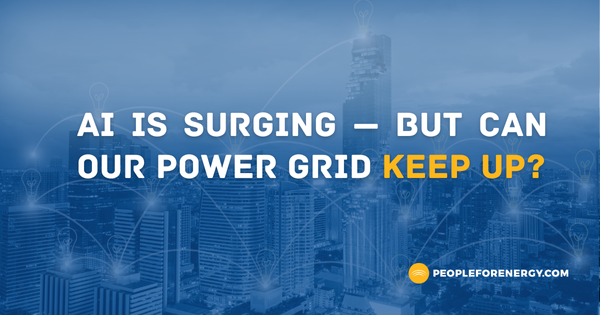Artificial intelligence (AI) is already part of our daily lives—from helping us get directions, to powering voice assistants, to detecting health issues earlier. But what most people don’t see is what powers AI itself: electricity. And a lot of it.
Every time an AI system answers a question or runs a program, it relies on data centers packed with powerful computers. These machines run day and night, using enormous amounts of energy. As AI becomes more common, those energy needs are only going to grow—and fast.
Why AI Uses So Much Power
AI systems don’t run on magic. They depend on high-powered machines that work nonstop to process data. Training just one advanced AI model can use as much energy as hundreds of homes do in a year.
Right now, data centers use about 2–3% of all the electricity in the U.S., and that number is expected to grow rapidly. The U.S. Department of Energy reports that data centers already consume around 4.4% of national electricity, with usage expected to rise as high as 12% by 2028. A McKinsey analysis confirms this trajectory, pointing to AI and cloud services as key drivers of massive new energy demand.
Because AI systems need constant, reliable electricity, our energy grid must be prepared—or the consequences will hit consumers first.
What Can We Do to Prepare?
America’s electricity use is already setting records. The U.S. Energy Information Administration projects a 2.5% increase in electricity demand from 2024 to 2025, driven in part by AI, data centers, electric vehicles, and manufacturing.
To make sure our energy grid can handle AI’s growth—and keep prices stable—we need to:
- Upgrade Our Energy Infrastructure
We must improve the power lines, substations, and systems that deliver electricity so they can support the extra load from AI data centers. A modern, resilient grid reduces outages and protects against blackouts or price shocks.
- Use a Mix of Energy Sources
It’s essential to have a diverse energy mix—including natural gas, nuclear, wind, and solar. AI systems operate 24/7, and we need energy sources that can do the same. That’s why dispatchable power like natural gas and nuclear is crucial—it provides steady power when renewables aren’t available, keeping the grid strong and prices more predictable.
- Build Data Centers in Smart Locations
Placing AI data centers near energy-rich regions and strong grid connections helps reduce costs and energy loss. States like Texas and Virginia already house large numbers of data centers, and their grid operators are feeling the pressure. The EIA and regional utilities warn that capacity constraints in areas like the PJM Interconnection could trigger future reliability risks if growth outpaces infrastructure.
As David Holt notes in RealClearEnergy, “data centers alone could account for nearly half of new electricity demand by 2028,” highlighting the pressing need for a robust and diversified energy strategy to support AI growth.
Why This Matters for the Economy
States with strong, reliable energy systems will attract more AI businesses—creating jobs, supporting local economies, and helping America remain competitive. According to RealClearEnergy, national leadership in AI may hinge on whether our energy systems can scale up fast enough.
As Consumer Energy Alliance President David Holt recently said in a radio interview: “America must strengthen its energy systems with practical, reliable solutions that meet both our tech ambitions and our consumer needs.”
The right energy policies today can help us lead in AI innovation—while protecting consumers from higher energy costs tomorrow.
The Bottom Line
AI is changing the world, but it can’t run without a strong, reliable power grid. If we want families, small businesses, and entire communities to benefit from AI, we need an energy system that’s ready to meet growing demand—without raising monthly bills or risking blackouts.
By upgrading our grid, using a balanced mix of energy sources, and planning smartly for where and how we build, we can power the AI revolution with energy that’s affordable, reliable, and secure for everyone.

